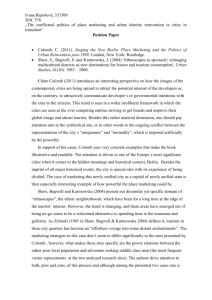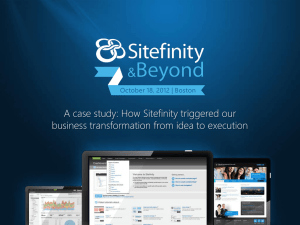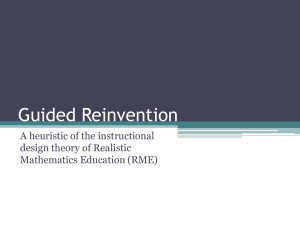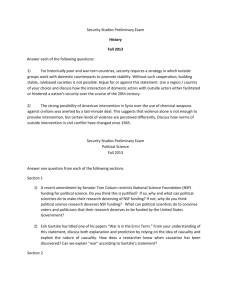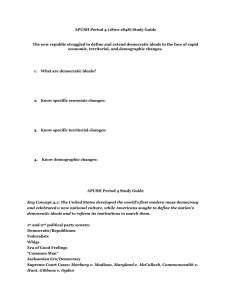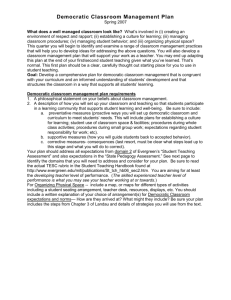DeLeon and Denhardt, Discussion of the Political Theory underlying
advertisement
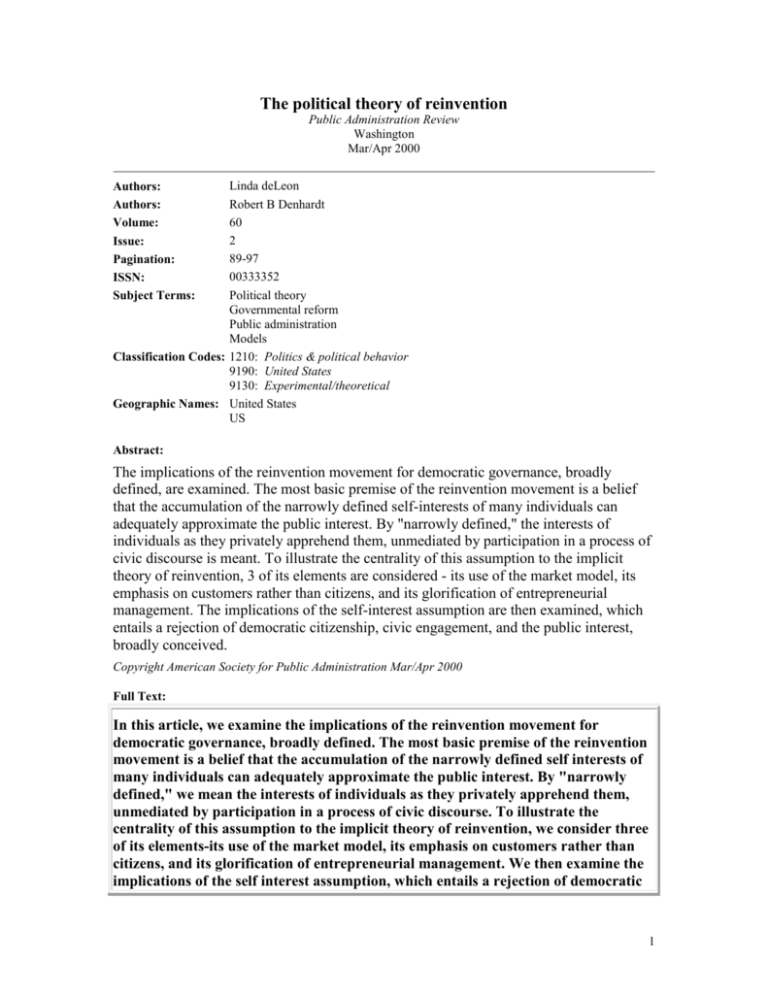
The political theory of reinvention Public Administration Review Washington Mar/Apr 2000 Linda deLeon Robert B Denhardt 60 2 89-97 00333352 Political theory Governmental reform Public administration Models Classification Codes: 1210: Politics & political behavior 9190: United States 9130: Experimental/theoretical Geographic Names: United States US Authors: Authors: Volume: Issue: Pagination: ISSN: Subject Terms: Abstract: The implications of the reinvention movement for democratic governance, broadly defined, are examined. The most basic premise of the reinvention movement is a belief that the accumulation of the narrowly defined self-interests of many individuals can adequately approximate the public interest. By "narrowly defined," the interests of individuals as they privately apprehend them, unmediated by participation in a process of civic discourse is meant. To illustrate the centrality of this assumption to the implicit theory of reinvention, 3 of its elements are considered - its use of the market model, its emphasis on customers rather than citizens, and its glorification of entrepreneurial management. The implications of the self-interest assumption are then examined, which entails a rejection of democratic citizenship, civic engagement, and the public interest, broadly conceived. Copyright American Society for Public Administration Mar/Apr 2000 Full Text: In this article, we examine the implications of the reinvention movement for democratic governance, broadly defined. The most basic premise of the reinvention movement is a belief that the accumulation of the narrowly defined self interests of many individuals can adequately approximate the public interest. By "narrowly defined," we mean the interests of individuals as they privately apprehend them, unmediated by participation in a process of civic discourse. To illustrate the centrality of this assumption to the implicit theory of reinvention, we consider three of its elements-its use of the market model, its emphasis on customers rather than citizens, and its glorification of entrepreneurial management. We then examine the implications of the self interest assumption, which entails a rejection of democratic 1 citizenship, civic engagement, and the public interest, broadly conceived. In 1992, David Osborne and Ted Gaebler published Reinventing Government, putting forward 10 principles through which "public entrepreneurs" might bring about massive governmental reform. The book captured the imagination of thousands of public managers and was widely discussed, debated, and even implemented. What we term the "reinvention movement" has been analyzed from a number of different perspectives (Fallows 1992; Frederickson 1992; Glastris 1992; Kettl 1994; Moe 1994). However, few of these articles have explored the underlying theoretical basis of the movement and its implications for broader issues of democratic governance. For the most part, past critiques have confronted the reinvention movement on its own terms, that is, with an interest in the practical implications of the movement for the operations of government, particularly at the federal level, where it has been given a presidential blessing. Though we draw on these works, our task is slightly different-to ! inquire into the implications of the reinvention movement for democratic governance, broadly defined. Before we begin, however, we should address a question that may well have already occurred to the reader: in speaking of the reinvention movement, do we refer to its theory or its practice, reinvention as it is played out? As we have suggested, our main task here is to explore the theory on which reinvention is based. In all political and administrative systems, there is always some discrepancy between theory and practice, for reasons we all understand. For example, vestiges of older systems may remain after new ones have been implemented. Or pockets of resistance may exist where deviants stubbornly hold other theories. Or it may simply be that human beings rarely get anything quite right. We suggest that our portrayal of the theory of reinvention does in fact describe its development in practice reasonably well (see, for example, Thompson and Riccucci's 1998 survey of the reinvention movement's ideology and implementation at federal, state, and local levels of government).! The most basic premise of the reinvention movement is that the accumulation of the narrowly defined self-interests of many individuals can adequately approximate the public interest. By "narrowly defined," we mean the interests of individuals as they privately apprehend them, unmediated by participation in a process of civic discourse. To illustrate the centrality of this assumption to the implicit theory of reinvention, we consider three of its elements-its use of the market model, its emphasis on customers rather than citizens, and its glorification of entrepreneurial management. We then examine the implications of the assumption of self-interest for democratic governance and especially for democratic citizenship. Administrative Reform as Political Theory In The Administrative State, first published in 1948, Dwight Waldo pointed out that although the earliest writers on public administration in this country were highly practical people-people concerned, for the most part, with the immediate technical operations of government-their writings implicitly constituted a political theory, a theory of democratic governance. Specifically, Waldo wrote, as the early writers commented on such topics as the good life, the criteria by which decisions are made, who should rule, how to maintain 2 a separation of powers, and centralization versus decentralization, they were, in effect, writing political philosophy. That the resulting body of thought was not intended as political theory made it no less consequential; indeed, this very fact may have made it more so. In his introduction to the second edition of The Administrative State, Waldo argued even more directly that this process is exactly how most political theories arise. On one hand, it is naive to think that people actively engaged in the work of governing would have the time and energy for theoretical thinking (much less writing). On the other hand, those who are isolated from government would not be expected to have the knowledge necessary to develop serious political theory. Rather, according to Waldo, " Consequential political theory, that is, political theory recognized contemporaneously or subsequently as related importantly to political reality and capable of generating belief or action, is characteristically produced 1) by a person not directly engaged in government but close enough to it for first-hand knowledge, and 2) a person not by intention 'theorizing' but rather seeking solutions to problems judged to be important and urgent" (1984, xxxiii). The ideal politica! l theorist would be one who observes government close at hand, perhaps even occasionally actively participating in the work of government, yet who is able to step back from that work for serious thought and reflection. Especially when the body of commentary that results from practical discussions of political and administrative issues becomes a movement-such as the scientific management movement, which Waldo saw as "overlapping or indistinguishable" with the public administration movement of the era in which he was writing-then it is incumbent on scholars to sort out the broader implications of the theory underlying the movement. This was the task Waldo set for himself in writing The Administrative State: to explicate "the political theories implicit and explicit in the public administration literature (more generally, movement)" ( 1984, xi). Bringing matters up to the present, we are now in a time in which a prevailing movement seems to be sweeping across the public administration landscape. It has a name, the "reinvention movement." It is complete with banners and slogans (such as "steer don't row"), and it is a movement whose central treatise, Reinventing Government (Osborne and Gaebler 1992), was constructed by individuals observing government close at hand, occasionally actively participating, then stepping back for a period of thought and reflection-in this case, a journalist and a former city manager, David Osborne and Ted Gaebler. Following Waldo, we would expect that, though clearly without intending to do so, Osborne and Gaebler and their followers have commented extensively on matters of broad interest and import, matters essentially related to political theory. We will explore this perspective by examining three aspects of the reinvention movement-the market model, the emphasis on customers, and entr! epreneurial management. The Market Model There is, of course, a long-standing tradition in public administration that government should be run like a business. For the most part, this recommendation has meant that government agencies should adopt practices, ranging from scientific management to total quality management, that have been found useful in the private sector. The reinvention 3 movement takes this idea one step further, arguing that government should not only adopt the techniques of business administration, but it should also adopt the values of business. Among these business values, the reinvention movement has accepted a wide variety, including the value of competition, preference for market mechanisms for social choice, and respect for the entrepreneurial spirit. In doing so, the reinvention movement relies heavily on such "intellectual cousins [as] public choice theory, principal agent theory, and transaction cost analysis (Kamensky 1996, 251)." And it does so unabashedly. In the pages of the Public Administration Review, John Kamensky (1996), one of the most thoughtful architects of the National Performance Review, ties the reinvention movement directly to public choice theory, quoting the New Zealander Jonathan Boston: "The central tenet of the public choice approach is that all human behavior is dominated by self-interest" (251). Kamensky correctly notes that "public choice theories have tended to reject concepts like 'public spirit,' 'public service,' and so forth." As it is employed in the reinvention movement, the market model has several important features. According to Osborne and Gaebler (chap. 10), the market model should be applied primarily to service providers, not to policy agencies or regulatory agencies. But wherever possible, the market model applied to government would feature competition between public and private sectors, competition among private firms vying for public contracts, competition among public agencies (for example, between public schools), and competition among governmental units to provide services to internal customers. Interestingly, the market model of the reinvention movement is not a purely free market. Indeed, it relies on managed or regulated competition, in which government retains the authority and responsibility to set rules governing transactions. It is, one might say, a conjunction of management and market. In any case, underlying the market model of government is an article of faith, a belief that the free play of market forces will bring self-interested participants-individuals, social groups, agencies, firms-into an equilibrium that represents, in some way, the maximum achievable social good. It implies that participants can serve the public interest simply by concentrating on their own selfinterest. Even under conditions of regulation, the guiding force is self-interest, in that participants will pursue their own self-interest competitively rather than attempting to discover a general public interest and collaborating to achieve it. The basic force of the market, its unseen hand, operates without deliberate direction. In fact, as Adam Smith is said to have remarked of his grocer, it does not matter to the operation of markets that individuals do not act out of benevolence or love of their fellow men (Solomon 1992, 14). The primary motivating force of the market is both sel! f correcting and likely to achieve beneficial societal results. No one can argue that competition does not have benefits in some situations. In sports, business, and even in nature, competition often leads to improvement. Using a similar logic, Osborne and Gaebler argue that market-oriented governmental programs have many advantages over conventional ones. They are decentralized, competitive, and responsive to changing conditions; they empower customers to make choices, and they link resources directly to results; and they allow government to leverage its power, achieving major changes by applying incentives strategically. Whether applied to governmental contracting, the choice of schools for one's children, or the selection of 4 low-income housing, the recommendation of the reinvention movement is consistent: to let the ebb and flow of the market guide not only individual choices, but ultimately the direction of society as a whole. Customer Service Closely related to reinvention's emphasis on the market model is its emphasis on customer-driven government. According to Osborne and Gaebler (chap. 6), customerdriven government has three tenets. First, government must listen carefully to its customers. Second, government should offer its customers choices between competing service providers (that is, create competition). Third, governments should give customers resources to use in selecting their own service providers. In our view, these ideas go beyond improving the quality of government service and, in fact, represent a particular political viewpoint, one that prefers a government that responds to the short-term selfinterests of isolated individuals (customers) rather than one that supports the pursuit of public interests publicly defined through a deliberative process (citizens). Certainly, no one would argue with the idea that government should provide the highest quality service to its citizens, within the constraints of law and available resources. Indeed, efforts by individual agencies and entire governments to improve service quality have proven quite beneficial. For example, a federal executive order requires federal agencies to more clearly define their internal and external customers and to establish and meet higher standards of service quality. In Great Britain, the Citizens' Charter movement not only requires higher standards of service quality, but also requires that citizens be compensated when those standards are not met. Similarly, many state and local governments in the United States and abroad are making efforts to improve customer service. There are, however, several difficulties with the notion of customer service. Obviously, the varied functions of government do not represent uniform products or even a "product line" as one might encounter in business. Rather, the work of government is extremely diverse in the way it originates, in the way it is performed, and in the way it is received. Some services, of course, such as traffic citations or incarceration, are not even services the immediate recipient wants. For these reasons, the relationship between those in public organizations and their customers is far more complex than the relationship between those behind the hamburger stand and their customers (Cope 1997). Similarly, the diversity of government activities means that even the first step in a service improvement effort, identification of the agency's customers, can be quite dif ficult. Private-sector customer service efforts often distinguish between internal and external customers, but the problem for government not only includes, but goes far beyond, that distinction. Among the categories of those dealt with by government are those who immediately present themselves (and their available resources) for the service, those who may be waiting for the service, relatives and friends of the immediate recipient, those who may need the service even though they are not actively seeking it, future generations of possible service recipients, and on and on, 5 Of even greater theoretical importance, some who approach government for services have greater resources and greater skill in bringing their demands forward. In business, that fact would justify special attention, but in government, it surely does not. In fact, an emphasis on customer relations in government may create a climate in which special privileges might be inappropriately granted. Also, many public services-such as schooling, environmental quality, or police protection-are designed to have a collective benefit. For example, we generally assume that having a more literate society is an important societal goal that goes beyond the effect of schooling on a particular individual. (Indeed, the fact that certain issues cannot be easily managed or marketed is exactly why they are in the public rather than the private sector.) Finally, the customer of business products or services is rarely the producer of those goods and services; yet in the public sector, the customer of! any government service is almost always at the same time a citizen-in a sense, the boss. As a citizen, the individual has a stake in all services that are delivered, not just those that he or she consumes directly. This feature is most clearly seen when a majority of citizens choose to limit the amount of money to be spent to deliver a particular service, even one many other customers want. The Administrator as Entrepreneur The third element of the reinvention movement, which we find particularly indicative of its underlying political theory, is its enthusiasm for what Osborne and Gaebler call "entrepreneurial government." In their preface, they define entrepreneurship as "us[ing] resources in new ways to maximize productivity and effectiveness" (1992, xix). But entrepreneurship connotes more than simple resourcefulness. Specifically, it entails creativity and innovation, a strong focus on ends (outcomes, mission) rather than means, and a proactive stance toward problems ("prevent [them] before they emerge, rather than simply offering services afterward," [20]). But most importantly, the idea of entrepreneurship suggests the individual government agent acting on his or her own selfinterest (or that of the agency). An example from Gaebler's own experience is used to make this point: "The idea was to get them thinking like owners; 'If this were my money, would I spend it this way?"' (3). The pa! rticular political viewpoint represented here is one that glorifies the innovative potential of the single self-interested individual over the powers of established institutional processes or the slower and more hesitating, but more involving and perhaps democratic, efforts of groups (compare to Green and Hubbell 1996). As is the case with customer service and the benefits of competition, no one can argue that "using resources in new ways to maximize productivity and effectiveness" is an unworthy goal. An observer who happens to be on Interstate 25 in Colorado at the right moment might see the pavement line marking machine from the City of Westminster crossing paths with the rotomill machine from Englewood. Certainly, the managers who engineered the reciprocal loans of these expensive pieces of equipment, rather than buying both for their own towns, saved the taxpayers money through their effective use of resources. Programs to cooperate with private firms that recycle oil or make compost not only dispose of materials that would otherwise fill municipal dumps, they also secondarily create business tax revenues for the city. 6 Although entrepreneurial activity on the part of government has these obvious benefits, it is also worth noting-as the private-sector advocates of entrepreneurship are aware-that it has liabilities as well. The essence of the strains involved in entrepreneurial activity is neatly captured in Schumpeter's description of it as "creative destruction" (1911). On the credit side of the ledger, entrepreneurs create and innovate; on the debit side, they may take excessive risks or run roughshod over people and principles. The "shadow" side of the entrepreneur is characterized by a narrow focus, an unwillingness to follow rules and stay within bounds, and a preference for action so strong as to threaten accountability ("It is better to ask forgiveness than permission" [deLeon, 1996]). Cutting red tapeor, as Barzelay (1992) calls it, "breaking through bureaucracy"-requires opportunism, single-mindedness, and extraordinary confidence in one's personal vision. Detailed biographies of three giants among public managers (Hyman Rickover, Herbert Hoover, and Robert Moses) led Eugene Lewis to conclude that "[they were not] criminals in any conventional sense. Rather, they were `rule benders.' They were crafty, and they pushed the limits of what was legal and permissible time after time without getting caught or, when caught, without serious punishment" (1980, 243). While the public desires creative solutions to public problems and likes the savings produced through innovative thinking (and even occasional risk-taking), it holds the notion of accountability to be extremely important as well (compare to Romzek and Dubnick 1987). As a practical matter, in real organizations, entrepreneurial managers pose a difficult and risky problem: they can be innovative and productive, but their single-mindedness, tenacity, and willingness to bend the rules make them very difficult to control. They can become loose cannons. As a theoretical concern, the notion of public managers acting purely as if the public's money were their own, that is, being motivated by self interest, flies in the face of a long and important tradition of accountability and responsiveness in democratic public administration (Box 1997; Miller and Simmons 1998; Terry 1998). Most importantly, it denies the public a role in determining the expenditure of public funds and the desig! n of public programs. As we will see treating the public's money as if it were indeed the public money is an important principle of democratic governance Self-interest vs. the Public Spirit In each of the three areas of reinvention theory discussed above, we have pointed out beneficial effects. Clearly, there are circumstances where market competition, customer services and entrepreneurial initiative are logical and desirable. But equally clearly, the choices expressed by the political theory of reinvention have important implications. In the discussion that follows, we argue that reinvention's faith in self-interest as a motivating force for public action is misplaced: it denigrates the role of collaborative action, produces an impoverished vision of the public interest, tends to exclude some persons from the public arena, and reduces trust among citizens and between them and their government. First, however, we should examine the way in which various political traditions have captured the distinction between self-interest and the public interest, or what Jane Mansbridge calls "the public spirit" (1990, 1992). 7 Michael Sandel, writing in Democracy's Discontent (1996), traces two traditions in American political life. The first tradition, which Sandel says has largely prevailed in recent history, describes the relationship between the state and its citizens in terms of procedures and rights. This view is based in a philosophy of self-interest and holds that government exists merely to mediate the specific personal and collective interests of those in society, to provide an arena in which self-interests can be played out and adjudicated. Here, government fulfills its responsibility to citizens by assuring that procedures are in place to guarantee that government operates according to democratic principlesthrough voting, representation, due process, and other devices-and that the rights of individuals, such as the right of free speech or the right to privacy, are protected. In this view, the citizen's role is to develop the capacity to choose pursuits that are consistent with his or ! her interest and to respect the rights of others to do the same. An alternative view of democratic citizenship sees the individual as much more actively sharing in self-government. The role of the citizen looks beyond self-interest to the larger public interest; it takes a broader and longerterm perspective. Obviously, such an interpretation of democratic citizenship asks much more of the individual. Among other things, it "requires a knowledge of public affairs and also a sense of belonging, a concern for the whole, a moral bond with the community whose fate is at stake; To share in selfrule therefore requires that citizens possess, or come to acquire, certain qualities of character, or civic virtues" (Sandel 1996, 5-6). Citizenship provides a mechanism through which the individual can integrate all the other roles that society assigns. Though there are certain "qualities of character" that the citizen should possess, there is also an assumption that active involvement in the political and governmental process will cultivate the very q! ualities that self-government requires. Through their involvement in civic action and the governance process, through their involvement in the process of building community, citizens are energized, focused, and made whole. Jane Mansbridge ( 1980, 1990, 1992) makes a similar distinction based on the notion of "public spirit"-she calls it "the political form of altruism," though we might also use such terms as virtue, principle, justice, or a concern for the public interest. The view of government based on accumulated self interest holds that governmental institutions should minimize the need for public spirit-that is, institutions should be created so that individuals acting in their own self-interest (rather than being imbued with the public spirit) arrive at mutually satisfactory solutions to common, as well as individual problems. Mansbridge disagrees, for two reasons: "First, public spirit is not simply a fixed and scarce resource that must be hoarded for emergencies and used sparingly. Rather, in some circumstances, the exercise of public spirit creates more public spirit, both in the actors and in those who notice their behavior. Second, context is crucial.... In the arenas where self-in! terested action is most likely to undermine the larger system, we should think consciously about which combinations of sanctions and altruistic motivations (public spirit) are most likely to generate cooperation" (1992, 153). The idea of a common undertaking in which all citizens can and must be involved is key. This collective enterprise, which is often called the public interest, is not just the accumulation of private interests, nor even the juxtaposition of "enlightened" self interests. Indeed, this ideal moves well beyond a politics based on the self-interest of the 8 individual. "In fact, it has little to do with our private interests, since it concerns the world that lies beyond the self, that was there before our birth and that will be there after our death, and that finds its embodiment in activities and institutions with their own intrinsic purposes which may be often at odds with our short term and private interests" (d'Entreves 1992, 154). In this political tradition, only as citizens act with reference to the public interest, the broader interest of the community, can they move from a lonely, isolated existence to one of virtue and fulfillment. The process of contributing to the commu! nity is ultimately what makes one whole. Of course, citizenship is not good simply because it produces warm, fuzzy feelings for the individual. Of at least equal importance is its role in producing a more harmonious social world. As Sheldon Wolin wrote in Politics and Vision ( 1960), "[C]itizenship provides what other roles cannot, namely an integrative experience that ... demands that the separate roles be surveyed from a more general point of view" (434). By requiring that we interact-that is, engage in democratic discourse-with others, participation broadens our perspectives and helps us see beyond our own narrow interests. In addition to expanding our intellectual understanding of the world, we also are forced to grow emotionally. As we participate in discourse, we are required to enter into the minds and hearts of others empathically and imaginatively, a point clearly made in several recent books and articles describing the "citizenship" movement in public administration (Box 1998; King and Stivers 1998). Thi! s shared experience creates within us not only "cultural competence," the ability to understand others, but also consensus itself. In the process of bouncing and crashing against others, our ideas and values are polished and their sharp edges rounded. As we learn to know and value others, our internalized idea of the public interest becomes more complex and balanced. Finally, the notion of democratic discourse and deliberation has an educative aspect. As a result of participating in decision-making, the individual develops habits of cooperative behavior that not only contribute to the community, but to the individual's own self worth as well. There is a sense in which citizenship builds character. The individual becomes more complete through involvement in public matters, a completeness that takes the individual beyond the narrowness of self interest. As Carole Pateman pointed out years ago, "the individual learns .. . that he has to take into account wider matters than his own immediate private interests if he is to gain cooperation from others, . . . he learns to be a public as well as private citizen" ( 1970, 25). Hannah Pitkin, among others, has pointed out that citizenship involves a transformation of narrowly defined self interest into a concern for others, for institutions, and for ideals (Schwartz 1988, 7). And in this way the c! ircle is complete-by moving beyond self-interest, not only does the individual contribute to the betterment of the democratic community, he or she grows personally, both in a public and a private sense. Reinvention as a Denial of Citizenship The political theory of reinvention, founded on a faith in individual self-interest as the engine that drives social good, in fact acts to deny the ideal of citizenship. Markets 9 The market model is not based on a deliberative process and, in fact, functions in ways that inhibit its development. Markets are anarchic. There is no ruling force that governs transactions, forcing buyers and sellers to conclude their self-interested "deals." In this Darwinist view, competition is a more common strategy than collaboration (although collaboration may occur within a group contending competitively for power). The market relies upon impersonal signals to reach equilibrium. Mere signals-such as prices in the economic market or votes in the political one-are impoverished by comparison to the complexity of language. Good communication is rich in nuance, both intellectual and emotional. An analogy with which students and professors are familiar are traditional grades: A, B, C, D, and F. These signals say very little and are disquietingly ambiguous, and few who participate in the grading process-students, faculty, or employers who look at transcripts (not many do)-profess satisfaction with it. Further, we should consider whether equilibrium-the point at which competing interests balance-is the best we can hope to achieve. In the oft-told tale of the three blind men who come upon an elephant, one touches the leg and thinks it is a tree trunk. Another touches the tusk and thinks it is a javelin. The third touches an ear and thinks it is a ship's sail. Only the omniscient observer (the hearer or the teller of the tale) can see what the elephant really is. So could the men, of course, if they could talk with each other. Or consider findings from the study of alternative dispute resolution (ADR) techniques (arbitration, mediation, negotiation). Resolving conflicts through adversarial legal proceedings produces solutions that are less stable and less satisfying to the participants than does ADR (Kressel and Pruitt 1989), because mediation and negotiation engage the disputants in dialog (either with or without a third party as referee). The legal system achieves equilibrium, but the outcomes that ADR can produce are better, for some of the same reasons that democratic discourse can produce better policy than can a political marketplace. Another way that the political theory implicit in the market model inhibits deliberative processes is its tendency to draw a sharp distinction between the public and the private spheres. As Camilla Stivers writes, "Classical liberalism has always seen boundaries around the public sphere as necessary to prevent tyranny, by sheltering individual, `private' concerns from the reach of the state. But paradoxically, the viability of liberal society, hence its public sphere, depends on the fulfillment of certain functions in the household, such as the provision of shelter, food, and clothing and the bearing and nurturing of children" (Stivers 1993, 4). Her book is an extended analysis of the way this view has tended to seclude women at home. Whereas men and women once worked together on the family farm, after industrialization, women were left to their domestic duties (rationalized by a "cult of domesticity," echoed today in Martha Stewart's ascendance), while men dominated the pu! blic world of business and politics. And despite affirmative action and equal opportunity, public administration remains "structurally male despite its apparent neutrality: It can only go on as it does because women bear a lopsided share of the burden of domestic functions without which life would simply not be possible" (Hochschild and Machung 1989; Stivers 1993, 5). 10 Political conservatives, among the strongest advocates of the market model, argue for limitations on government's reach, that is a narrowing of the public sphere and a concomitant protection of the sphere of private conduct. Of course, most conservatives do not seek to obliterate government: they are quite content to have it enforce contracts, preserve managerial control of employees, and (often) impose a variety of constraints on (for example) sexual behavior. But the conservative position does militate against social control of domestic life and government restrictions on business activity. Some observers suggest that a narrowing of the public sphere has occurred over recent decades. Robert Putnam (1995) in his widely read essay, "Bowling Alone," documents the depletion of "social capital"-the extensive network of formal and informal associations through which Americans used to fulfill social needs. Although the matter is debatable (some observers suggest there is an increase in volunteer activity), if true, it represents a reduction in the degree to which ordinary Americans participate in public life and, therefore, a restriction of their opportunities to engage in productive discourse. Customer Service The restrictive nature of the consumer relationship is easily seen, both in terms of our ordinary expectations of government and public service and in our theoretical commitments to democratic citizenship. Henry Mintzberg, the Canadian management theorist, points out the variety of relationships that citizens have with their governmentscustomers, clients, citizens, and subjects-and suggests that the label "customer" is particularly confining. I am not a mere customer of my government, thank you," he writes. I expect something more than arm's-length trading and something less than the encouragement to consume" (1996, 77). As citizens, we expect government to act in a way that not only promotes the consumption of services (Mintzberg also asks, "Do we really want our governments ... hawking products?"), but also promotes a set of principles and ideals that are inherent in the public sphere. Most importantly, the self-interested customer is a divided self, seeking from one time to another the satisfaction of different parts of the self (food, entertainment, etc.). And while these different aspects of the self may interact (a principle well-known to marketing experts who seek to sell cars by describing their sex appeal), the consuming self remains always less than whole. The consumer can never fill all the needs that seem to present themselves, in part because there is never enough money to buy everything that the consuming self desires, and in part because, even if money were not an object, money cannot buy emotional or spiritual satisfaction-it can buy neither love, nor happiness, nor self-esteem, nor the high regard of others. An important aspect of the citizenship role, however, is exactly its capacity to integrate the various aspects of the self and to extend beyond the individual's existing capacities to expand and develop personality and character. As we have suggested earlier, in the process of deliberative interaction, individuals expand their understanding and appreciation of the needs and interests of others, internalizing this understanding and moving toward a broader and more inclusive vision of the public interest. Citizenship is an integrative experience that the competitive relations of the marketplace do not seek to, and cannot, provide. 11 Entrepreneurship In the public administration literature, several voices have cautioned against overenthusiastic embrace of entrepreneurship. Bellone and Goerl (1992), for example, argue that entrepreneurship places value on autonomy, personal vision, secrecy, and risktaking, which are opposed to administrative values such as democratic accountability, participation, openness, and stewardship. They propose that the conflict can be resolved with a "civic-regarding" entrepreneurship. Terry (1993) maintains that some aspects of entrepreneurship are fundamentally undemocratic, in that it sanctions domination and romanticizes revolutionary change (see also, Terry 1998). The entrepreneurial leap is intuitive, creative, and nonrational (it would be meaningless to speak of rationality where both means and ends are not settled). But in this formulation of the nature of entrepreneurial action we can detect, behind the heroic figure of the entrepreneur, the ghost of Nietzsche's Superman. The irrationalist philosophies of which his was a precursor (Sabine 1961) rejected rational calculation in favor of "the insight of genius, or the inarticulate cunning of instinct, or the assertiveness of will and action" (889). These alternative decision rules were contrasted with reason as being "creative rather than critical, profound rather than superficial, natural rather than conventional, uncontrollable and demonic rather than methodical" (Ibid.). And in place of the individualism of the Enlightenment was set the cult of the Volk, which acted collectively rather than by individual invention. But the parallel drawn here between the figure of the entrepreneur and the Ubernensch is meant critically: when we turn to a superhero to solve problems, we risk the same dangers that are courted when national states place their fate in the hands of untrammeled leaders. The corollary of faith in entrepreneurship is a lack of faith in the ability of groups to be creative, flexible, and tenacious. The implicit message is that the problems of today's world cannot be solved by the plodding, mundane efforts of ordinary people, but instead require an inspired and visionary leader. While leadership is a function that must be fulfilled for a collectivity to accomplish its goals, mythologizing individual leadership fosters dependency on the part of group members. Conclusion As Dwight Waldo pointed out many years ago, our dayto-day thinking, talking, and writing-whether in universities or in the agencies of government-has important theoretical and valuational underpinnings and consequences. The immediate work of designing new institutions, managing in new and innovative ways, creating systems for choice and accountability, as well as all the other seemingly mundane tasks of government, express deeplyrooted sentiments about the nature of democratic governance. As we respond to ideas such as those heralded by the reinvention movement or any other fad that happens by, we must clearly understand that in our actions or our writings, we are rejecting or accepting a particular political viewpoint. We are making political theory. The reinvention movement speaks clearly to the political theory of our time. In its use of the market model, in its emphasis on customers rather than citizens, and in its glorification of entrepreneurial management, the movement contributes to a political 12 theory based on the idea that the public interest can be approximated through the accumulation of the narrowly defined self interests of many individuals. This approach is not an unfamiliar one to students of political theory, but administrators who support the reinvention movement must recognize the implicit political theory they are supporting. And they should recognize the aspects of democratic governance that they are rejectingdemocratic citizenship, civic engagement, and the public interest (more broadly conceived). Many, we suspect, will be uneasy to realize that they are moving away from such fundamental values. References Barzelay, Michael. 1992. Breaking through Bureaucracy. Berkeley, CA: University of California Press. Bellone, Carl J., and George Frederick Goerl. 1992. Reconciling Public Entrepreneurship and Democracy. Public Administration Review 52(3): 130-34. Box, Richard C. 1998. Citizen Governance. Thousand Oaks, CA: Sage Publications. .1999. Running Government like a Business: Implications for Public Administration Theory and Practice. American Review of Public Administration 29(2): 1913. Cope, Glen Hahn. 1997. Bureaucratic Reform and Issues of Political Responsiveness. Journal of Public Administration Research and Theory 7(3): 46171. deLeon, Linda. 1996. Ethics and Entrepreneurialism. Policy Studies Journal 24(3): 495-510. d'Entreves, Maurizio Passerin. 1992. Hannah Arendt and the Idea of Citizenship. In Dimensions of Radical Democracy, edited by Chantal Mouffe, 145-68. London: Verso. Fallows, James. 1992. A Case for Reform. Atlantic Monthly 270(2): 119-123. Frederickson, George. 1992. Painting Targets Around Bullet Holes. Governing 6(1): 13. Glastris, Paul. 1992. Paradigm Glossed. Washington Monthly April: 399. Green, Richard T., and Lawrence Hubbell. 1996. On Governance and Reinventing Government. In Refounding Democratic Public Administration, edited by Gary L. Wamsley and James F. Wolf, 387. Thousand Oaks, CA: Sage Publications. Hochschild, Arlie, and Anne Machung. 1989. The Second Shift. New York: Viking Books. 13 Kamensky, John M. 1996. The Role of the Reinventing Government Movement in Federal Management Reform. Public Administration Review 56(3): 247-55. Kettl, Donald R 1994. Reinventing Government? Appraising the National Performance Review (CPM Report 94-2). Washington, DC: The Brookings Institution. King, Cheryl, and Camilla Stivers. 1998. Government is Us. Thousand Oaks, CA: Sage Publications. Kressel, Kenneth, and Dean G. Pruitt. 1989. A Research Perspective on the Mediation of Social Conflict. In Mediation Research, edited by Kenneth Kressel and Dean G. Pruitt, 394435. San Francisco: Jossey-Bass. Lewis, Eugene. 1980. Public Entrepreneurship. Bloomington: Indiana University Press. Mansbridge, Jane J. 1980. Beyond Adversary Democracy. New York: Basic Books. .1990. Beyond Self interest. Chicago: University of Chicago Press. .1992. Public Spirit in Political Systems. In Values and Public Policy, edited by Henry J. Aaron, Thomas E. Mann, and Timothy Taylor. Washington, DC: The Brookings Institution, 146-72. Miller, H. T., and J. R. Simmons. 1998. The Irony of Privatization. Administration and Society 30(5): 513-32. Mintzberg, Henry. 1996. Managing Government, Governing Management. Harvard Business Review 74(3): 75-83. Moe, Ronald C. 1994. The "Reinventing Government" Exercise: Misinterpreting the Problem, Misjudging the Consequences. Public Administration Review 54(2): 111-22. Osborne, David, and Ted Gaebler. 1992. Reinventing Govern ment. Reading, MA: Addison-Wesley. Pateman, Carole. 1970. Participation and Democratic Theory. Cambridge: Cambridge University Press. Putnam, Robert D. 1995. Bowling Alone: America's Declining Social Capital. Journal of Democracy 6: 65-78. Romzek, Barbara S., and Melvin J. Dubnick. 1987. Accountability in the Public 14 Sector: Lessons from the Challenger Tragedy. Public Administration Review 47(3): 227-38. Sabine, George H. 1961. A History of Political Theory. 3rd ed. New York: Holt, Rinehart and Winston. Sandel, Michael J. 1996. Democracy 's Discontent. Cambridge, MA: Belknap Press of Harvard University Press. Schumpeter, Joseph. 1934. The Theory of Economic Development. Cambridge, MA: Harvard University Press. Schwartz, N. L. 1988. The Blue Guitar: Political Representation and Community. Chicago: University of Chicago Press. Solomon, R. C. 1992. Ethics and Excellence. New York: Oxford University Press. Slivers, Camilla. 1993. Gender Images in Public Administration. Newbury Park, CA: Sage Publications. Terry, Larry D. 1993. Why We Should Abandon the Misconceived Quest to Reconcile Public Entrepreneurship with Democracy. Public Administration Review 53(4): 393-95. .1998. Administrative Leadership, Neo-Managerialism, and the Public Management Movement. Public Administration Review 58(3): 194-200. Thompson, Frank J., and Norma M. Riccucci. 1998. Reinventing Government. Annual Review of Political Science 1: 231-57. Waldo, Dwight. 1980. The Enterprise of Public Administration. Novato, CA: Chandler and Sharp. .1984. The Administrative State. 2d ed. New York: Holmes and Meier Publishers. Wolin, Sheldon S. 1960. Politics and Vision: Continuity and Innovation in Western Political Thought. Boston: Little, Brown. Linda deLeon University of Colorado at Denver Robert B. Denhardt Arizona State University Linda deleon is an associate professor at the Graduate School of Public Affairs, University of Colorado at Denver, where she directs the Executive Master of Public Administration Program and the Rocky Mountain MPA Program (on-line). Her 15 research interests include organization theory human resources management administrative reform, public-sector professionals, and ethics and values in organizations. Robert e. Denhardt is a professor of public affairs at Arizona State University and a visiting scholar at the University of Delaware. He is a former president of the American Society of Public Administration and o member of the National Academy of Public Administration. His teaching and research interests are leadership and organizational change. Reproduced with permission of the copyright owner. Further reproduction or distribution is prohibited without permission. 16

